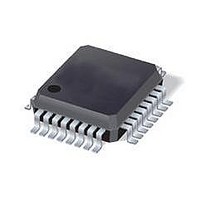ST7FLITE49K2T6TR STMicroelectronics, ST7FLITE49K2T6TR Datasheet - Page 118

ST7FLITE49K2T6TR
Manufacturer Part Number
ST7FLITE49K2T6TR
Description
IC MCU 8BIT 8K FLASH 32LQFP
Manufacturer
STMicroelectronics
Series
ST7r
Datasheet
1.ST7FLITE49K2T6TR.pdf
(245 pages)
Specifications of ST7FLITE49K2T6TR
Core Processor
ST7
Core Size
8-Bit
Speed
8MHz
Connectivity
I²C, SPI
Peripherals
LVD, POR, PWM, WDT
Number Of I /o
24
Program Memory Size
8KB (8K x 8)
Program Memory Type
FLASH
Eeprom Size
256 x 8
Ram Size
384 x 8
Voltage - Supply (vcc/vdd)
2.4 V ~ 5.5 V
Data Converters
A/D 10x10b
Oscillator Type
Internal
Operating Temperature
-40°C ~ 85°C
Package / Case
32-LQFP
Processor Series
ST7FLITE4x
Core
ST7
Data Bus Width
8 bit
Data Ram Size
384 B
Interface Type
I2C, SPI
Maximum Clock Frequency
8 MHz
Number Of Programmable I/os
24
Number Of Timers
4
Maximum Operating Temperature
+ 85 C
Mounting Style
SMD/SMT
Development Tools By Supplier
ST7FLITE-SK/RAIS, ST7FLI49M-D/RAIS, STX-RLINK
Minimum Operating Temperature
- 40 C
On-chip Adc
10 bit, 10 Channel
For Use With
497-8399 - BOARD EVAL ST7LITE49M/STLED316S497-5858 - EVAL BOARD PLAYBACK ST7FLITE
Lead Free Status / RoHS Status
Lead free / RoHS Compliant
Available stocks
Company
Part Number
Manufacturer
Quantity
Price
Company:
Part Number:
ST7FLITE49K2T6TR
Manufacturer:
STMicroelectronics
Quantity:
10 000
- Current page: 118 of 245
- Download datasheet (4Mb)
On-chip peripherals
Note:
118/245
16-bit read sequence (from either the counter register or the alternate counter register)
Figure 56. 16-bit read sequence
The user must read the MSB first, then the LSB value is buffered automatically.
This buffered value remains unchanged until the 16-bit read sequence is completed, even if
the user reads the MSB several times.
After a complete reading sequence, if only the CLR register or ACLR register are read, they
return the LSB of the count value at the time of the read.
Whatever the timer mode used (input capture, output compare, one pulse mode or PWM
mode) an overflow occurs when the counter rolls over from FFFFh to 0000h then:
●
●
If one of these conditions is false, the interrupt remains pending to be issued as soon as
they are both true.
Clearing the overflow interrupt request is done in two steps:
1.
2.
The TOF bit is not cleared by accesses to ACLR register. The advantage of accessing the
ACLR register rather than the CLR register is that it allows simultaneous use of the overflow
function and reading the free running counter at random times (for example, to measure
elapsed time) without the risk of clearing the TOF bit erroneously.
The timer is not affected by Wait mode.
In Halt mode, the counter stops counting until the mode is exited. Counting then resumes
from the previous count (device awakened by an interrupt) or from the reset count (device
awakened by a reset).
External clock
The external clock (where available) is selected if CC0 = 1 and CC1 = 1 in CR2 register.
The status of the EXEDG bit in the CR2 register determines the type of level transition on
the external clock pin EXTCLK that triggers the free running counter.
The counter is synchronized with the falling edge of the internal CPU clock.
The TOF bit of the SR register is set.
A timer interrupt is generated if:
–
–
Reading the SR register while the TOF bit is set.
An access (read or write) to the CLR register.
TOIE bit of the CR1 register is set and
I bit of the CC register is cleared.
Beginning of the sequence
Sequence completed
At t0 +Δt
At t0
Read MSB
instructions
Read LSB
Other
Returns the buffered
LSB is buffered
LSB value at t0
ST7LITE49K2
Related parts for ST7FLITE49K2T6TR
Image
Part Number
Description
Manufacturer
Datasheet
Request
R

Part Number:
Description:
STMicroelectronics [RIPPLE-CARRY BINARY COUNTER/DIVIDERS]
Manufacturer:
STMicroelectronics
Datasheet:

Part Number:
Description:
STMicroelectronics [LIQUID-CRYSTAL DISPLAY DRIVERS]
Manufacturer:
STMicroelectronics
Datasheet:

Part Number:
Description:
BOARD EVAL FOR MEMS SENSORS
Manufacturer:
STMicroelectronics
Datasheet:

Part Number:
Description:
NPN TRANSISTOR POWER MODULE
Manufacturer:
STMicroelectronics
Datasheet:

Part Number:
Description:
TURBOSWITCH ULTRA-FAST HIGH VOLTAGE DIODE
Manufacturer:
STMicroelectronics
Datasheet:

Part Number:
Description:
Manufacturer:
STMicroelectronics
Datasheet:

Part Number:
Description:
DIODE / SCR MODULE
Manufacturer:
STMicroelectronics
Datasheet:

Part Number:
Description:
DIODE / SCR MODULE
Manufacturer:
STMicroelectronics
Datasheet:

Part Number:
Description:
Search -----> STE16N100
Manufacturer:
STMicroelectronics
Datasheet:

Part Number:
Description:
Search ---> STE53NA50
Manufacturer:
STMicroelectronics
Datasheet:

Part Number:
Description:
NPN Transistor Power Module
Manufacturer:
STMicroelectronics
Datasheet:

Part Number:
Description:
DIODE / SCR MODULE
Manufacturer:
STMicroelectronics
Datasheet:











